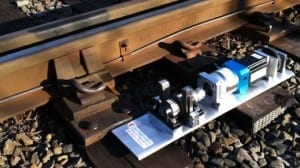Stony Brook University have developed a new patent-pending electromagnetic energy harvester
Much of the abundant mechanical energy around us is irregular and oscillatory and can be somewhat difficult to efficiently tap into. Typical energy harvesting systems tend to be built for low power applications in the milliwatts range but researchers from New York’s Stony Brook University have developed a new patent-pending electromagnetic energy harvester capable of harnessing the vibrations of a locomotive thundering down a stretch of track to power signal lights, structural monitoring systems or even track switches.
As a train rolls down the track, the load it exerts on the track causes vertical deflection. This displacement could engage a regenerative device like an electromagnetic harvester and generate enough power to operate local railway applications, which is especially useful in remote areas where electrification is not cost effective. Harvesting such energy is much more efficient with regular, unidirectional motion, but track vibrations caused by a moving train are pulse-like, bidirectional and somewhat erratic.
Professor Lei Zuo and graduate students Gopinath Reddy Penamalli, Teng Lin and John Wang from the University’s Department of Mechanical Engineering claim to have designed a new harvester capable of converting irregular, oscillatory rail track vibrations into regulated unidirectional rotational motion, similar to the way that an electric voltage rectifier converts AC voltage into DC.
“The U.S. has the longest rail tracks in the world, approximately 140,700 miles; that are often in remote areas,” said Professor Zuo. “It is very important but also very costly to power the track-side electrical infrastructure, such as the signal lights, cross gates, track switches and monitoring sensors. Our invention (the Mechanical Motion Rectifier based Railroad Energy Harvester) can harness 200 watts of electric energy from train-induced track deflections to power the track-side electrical devices. By using two one-way clutches, the innovative mechanical motion rectifier converts the irregular up-and-down vibration motion into unidirectional rotation of the generator, thus breaking the fundamental challenge of vibration energy harvesting and offering significant advantages of high efficiency and high reliability.”
Impact forces from repeated loading/unloading are also said to be reduced thanks to the incorporation of a flywheel to stabilize the generator. According to Professor Zuo, the technology enables a generator to rotate in one direction with relative steady speed in a more efficient speed region, and changes the negative influence of motion inertia into a positive, thereby reducing mechanical stress and increasing system reliability. Bench testing of system prototypes has resulted in mechanical efficiency of between 55 and 72 percent.
“Such a design not only avoids the challenges of friction and impact induced by oscillation motion, but also enables us to make full use of the pulse-like features of track vibration to harvest more energy,” he said.
Professor Zuo estimates that the implementation of such a device could save more than US$10 million in trackside power supply costs for the New York State area alone, together with a reduction of 3,000 tons of carbon dioxide every year.
via Gizmag – Paul Ridden
The Latest Streaming News: Energy harvesting updated minute-by-minute
Bookmark this page and come back often
Latest NEWS
Latest VIDEO


